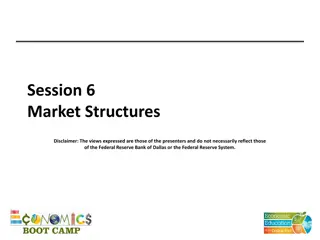Market Structures and Competition Overview
Market structures in economics define the competitive characteristics of different markets. Perfect competition features many small firms producing identical products as price takers. Monopoly has one seller with significant market power, while monopolistic competition involves firms with some marke
4 views • 5 slides
Price Leadership in Oligopoly Markets
Explanation of price and output determination in markets with a dominant firm exhibiting price leadership. The dominant firm utilizes market demand and small firms' supply curves to maximize profits, setting prices accordingly. Small firms follow the leader's pricing, collectively producing a portio
1 views • 5 slides
Understanding Monopolistic Competition and Oligopoly
Learn about the characteristics of monopolistic competition and oligopoly in the marketplace. Discover terms like Monopolistic Competition, Differentiation, Nonprice Competition, and Oligopoly. Understand how monopolistic competition involves similar but not identical products, while oligopoly is do
1 views • 15 slides
Understanding Revenue Concepts in Different Market Conditions
Explore revenue concepts like Total Revenue (TR), Marginal Revenue (MR), and Average Revenue (AR) along with elasticity of demand in various market structures such as perfect competition, monopoly, monopolistic competition, and oligopoly. Learn about short and long-run equilibrium conditions and the
0 views • 21 slides
Understanding Game Theory and Oligopoly in Economics
Game theory is a valuable tool for analyzing strategic interactions among players in situations like oligopoly. The concept of dominant strategy and the classic example of the Prisoner's Dilemma shed light on how individual rationality can lead to suboptimal outcomes. The practical example of a cell
1 views • 27 slides
Understanding Oligopoly in Microeconomics
Introduction to oligopoly, a market structure between perfect competition and pure monopoly. In oligopoly, only a few sellers offer similar or identical products, leading to a balance between cooperation and self-interest. Characteristics of an oligopoly market include interdependence among firms an
0 views • 46 slides
Understanding the Kinked Demand Curve Model in Oligopoly
The kinked demand curve model in oligopoly, developed by Paul M. Sweezy, highlights stability in pricing and output decisions among firms. This model suggests that rival firms may react asymmetrically to price changes, leading to a kink at a certain price level. Assumptions include few firms produci
3 views • 7 slides
Understanding Oligopoly Market Structure
This content delves into oligopoly, a market structure characterized by high concentration ratios and strategic interactions among a few sellers. It explores market concentration ratios in various U.S. industries, strategic behavior in oligopoly, and the challenges of collusion. Through examples lik
0 views • 10 slides
Understanding Oligopoly and Game Theory in Antitrust Economics
Oligopoly theory explores the dynamics of competition among a few large firms that impact pricing strategies. Industries range from competitive to monopolistic based on market structure. Game theory analyzes strategic interactions among firms in oligopolistic markets, influencing decisions and outco
0 views • 24 slides
Understanding Oligopoly and Game Theory in Economics
Explore the concepts of game theory and oligopoly in economics, including strategic behavior, dominant strategy, self-enforcing agreements, Nash equilibrium, and more. Learn how decision-making in oligopolies is influenced by the actions of competitors, and why collusion agreements may be disrupted
0 views • 28 slides
Oligopoly Behavior: Excess Capacity Models and Entry Deterrence Strategies
Examine the concept of excess capacity models in oligopoly behavior, where a monopolist may strategically deter entry by either building excess capacity or expanding current production facilities in response to potential entrants. Explore scenarios involving sunk costs, marginal costs, pricing strat
0 views • 37 slides
Understanding Market: Meaning and Classification
Market signifies a space where buyers and sellers interact to exchange goods for money. In economics, it refers to the entire region where such transactions occur. Markets can be classified based on geographical location, period of existence, and the number of buyers and sellers. Various market type
0 views • 8 slides
Understanding Market Structures and Business Ownership
Explore the characteristics of different market structures like pure competition, monopolistic competition, oligopoly, and monopoly. Learn about types of business ownership such as sole proprietorships, partnerships, and corporations. Discover the regulations affecting businesses and the economic ri
0 views • 20 slides
Strategic Insights into Bhansali Engineering Polymers Ltd
Bhansali Engineering Polymers Ltd (BEPL) is a well-established ABS manufacturer in a competitive oligopoly market, known for its low-cost specialty variants. With steady revenue growth, strategic expansions, and high margins, BEPL exhibits promising potential for investors. The company's greenfield
0 views • 5 slides
Understanding the Kinked Demand Curve Hypothesis in Oligopoly Markets
In oligopoly markets, prices often remain rigid despite cost changes. The kinked demand curve hypothesis, introduced by economist Sweezy, explains this phenomenon. It suggests that the demand curve an oligopolist faces has a kink at the current price level, with elastic demand above and inelastic de
0 views • 4 slides














